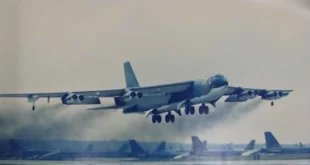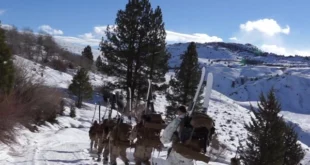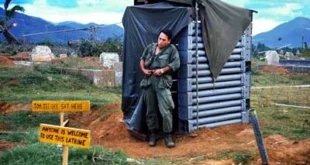By Sgt. John Jackson
Marine Attack Squadron 211
From the January 2013 issue of SOF

Sgt. Rasheem Thomas never thought his first night working on Camp Bastion would turn into a gun battle with 15 insurgents.
When Thomas was told he was transferring from 1st Platoon to 2nd Platoon, the landing support specialist with Combat Logistics Battalion 2, Combat Logistics Regiment 15, thought nothing of it. Instead of working on Camp Leatherneck, Thomas would be working at the rotary wing Arrival Departure Airfield Control Group (A/DACG) on Camp Bastion, an adjoining base run by British armed forces. He would be responsible for getting coalition forces and cargo on helicopters departing Camp Bastion’s airfield heading for remote forward operating bases throughout Regional Command Southwest’s area of operations.
Thomas’ first night on Camp Bastion was Friday, 14 September. He and a fellow sergeant were driving through a checkpoint close to the airfield when they heard an explosion.
“At first we didn’t know if the explosion was on base or off,” said Thomas, from Manhattan, N.Y. “We decided to go check on our Marines at the cargo lot and we saw an explosion by the (cryogenics) area. That’s when we knew the base was under attack.”

Fifteen insurgents dressed in U.S. Army uniforms armed with automatic rifles, shoulder-fired antitank rocket launchers, and suicide vests breached the base’s perimeter fence at approximately 10 p.m. The insurgents, who were organized into three teams, began to attack fixed and rotary wing aircraft parked on the flightline, aircraft hangars and other buildings on Camp Bastion.
“When I actually saw it was happening on (Camp) Bastion, I was in a bit of shock,” Thomas said. “Then rounds began to impact close to our position, and I think everyone’s training just immediately kicked in.”
When the attack began, the landing support specialists were in three different locations. Three Marines were at the A/DACG, four Marines where at the cargo lot and the remaining Marines were in their living spaces.
“I started hearing explosions, so I went outside to see what was going on,” said Staff Sgt. Justin Pauley, the landing support detachment chief. “I saw an RPG [rocket] flying overhead, and I immediately told my Marines to get their (personal protective equipment) on.”
Despite small-arms and indirect fire impacting around his position, Pauley knew he had to make contact with his higher headquarters on Camp Leatherneck to inform them of the current situation he and his Marines found themselves.
“I called the (Command Operations Center) and told them we were under attack and taking fire,” said Pauley, from Sioux Falls, S.D. “I told them about the situation and what I saw.”
After relaying the information to his chain of command, Pauley ensured his three Marines and one civilian at the A/DACG had proper cover, and then he and his Marines began to provide security, ensuring no insurgents made it past their position.
Support from the sky

When the first explosion happened, Lt. Col. Stephen Lightfoot, the commanding officer of Marine Light Attack Helicopter Squadron 469, thought the blast was relatively close. Occasionally, friendly forces conduct controlled detonations outside the perimeter fence; however, this explosion seemed to be a little louder and closer.
“I went outside after hearing the first explosion and within 15 seconds I heard another explosion,” said Lightfoot. “That’s when I saw the flames on the Harrier flightline. I yelled out for everyone to get to the (indirect fire) bunkers on our compound.”
One of the insurgent teams went to the AV-8B Harrier flightline and began to attack the jets and personnel. By the conclusion of the assault, six Harriers had been destroyed and two others significantly damaged. Upon seeing the fire and explosions, Lightfoot knew he needed to get his aircraft in the sky, not only to provide overwatch and close-air support but also to protect the aircraft.
“I had to get the aircraft airborne,” said Lightfoot, from Azusa, Calif. “I told the duty (operations officer) to sound the Troops in Contact alarm and get the alert aircraft airborne immediately.”
Hearing the Troops in Contact alarm at the HMLA-469 compound is nothing new for the Marines. The AH-1W Cobras and the UH-1Y Huey helicopters are often called to provide air support to coalition forces who are engaged with enemy forces. However, responding to their own alarm is something the Marines had not done before.
“Usually we respond to TICs for other units,” said Lightfoot. “However, everyone acted instinctively, got to the aircraft and got the alert aircraft launched despite taking fire on the flightline.”
Once airborne, the alert aircraft had challenging conditions in which to fly. In addition to armed insurgents on the ground, the pilots had to overcome other obstacles.
“It was a very dark night. There was no moon,” said Lightfoot. “However, on the flightline there were multiple aircraft on fire and a couple other areas were on fire as well, so it was extremely bright. There were 50- to 100-foot flames and a lot of thick smoke.”
While the flying conditions were complex, the commanding officer’s biggest concern was the Marines and coalition forces engaging the insurgents.
“We knew we had a lot of friendly (forces) on the ground,” Lightfoot said. “We wanted to make sure we did no harm to them or to their positions.”

Engaging the enemy
Thomas and his landing support specialists at the cargo lot on Camp Bastion saw four insurgents make their way down the flightline. They knew they needed to maneuver to find better positions to engage the enemy. At the same time, a British quick reaction force (QRF) was arriving on scene to assist in the counterattack.
“I attached myself with the British QRF while some of my other Marines held and maintained security at the cargo lot and on the flightline,” Thomas said.
The British QRF, along with Marines from CLB-2 and 3rd Marine Aircraft Wing (Forward), began to push toward the enemy and engage their position. Additionally, the alert aircraft from HMLA-469 were able to see coalition forces engaging the insurgents.
“One of our Marines on the ground was using night vision goggles and engaging the enemy from the ground,” Lightfoot said. “Additionally, the pilots saw the QRF engaging the same position.”
Once the pilots confirmed the enemy position, they were able to employ their respective aircraft weapons systems to eliminate one team of insurgents.
Following their first engagement, the alert aircraft maintained radio communication with Marine Attack Squadron 211, the Harrier squadron, on the ground. The Harrier squadron was able to relay location information about another group of insurgents to the helicopters providing close-air support.
“(VMA-211) told the pilots where the enemy was,” Lightfoot said. “They used the information to engage the enemy from approximately 200 feet in the air and were able to eliminate the threat. The pilots were danger-close to friendly positions, but were able to use the information received to engage the enemy without endangering friendly forces,” said Lightfoot.
Every Marine a rifleman
Fires continued to burn through the night, but rounds ceased being fired a few hours after the first explosion. Fourteen insurgents were killed and one was wounded and taken into custody by coalition forces.

Two Marines, Lt. Col. Christopher Raible, the commanding officer of Marine Attack Squadron 211, and Sgt. Bradley Atwell, an aircraft electrical, instrument and flight control systems technician with Marine Aviation Logistics Squadron 16, were killed during the attack. Additionally, eight coalition personnel and one civilian contractor were wounded.
Marines with CLB-2 and 3rd MAW (Fwd), as well as British forces with the QRF, maintained security of the airfield for the remainder of the evening. Five aircraft with HMLA-469 patrolled the skies over Camp Bastion until the sun rose, ensuring no additional insurgents tried to gain access to the base.
Looking back on the attack, the Marines felt as if everyone knew exactly what they needed to do to fight off the insurgents.
“This was totally new to most of the Marines,” said Thomas. “But everyone listened, everyone stayed together. We had great communication, maintained proper sectors of fire and had full accountability of our Marines.”
“Every Marine is a rifleman,” Lightfoot said. “Marines of every military occupational specialty in the squadron, to include AH-1W and UH-1Y aircraft mechanics, dropped their wrenches and grabbed their rifles to defend the HMLA-469 compound from a well-armed enemy. Through the coordinated use of ground and aerial-delivered fires, in danger-close proximity to friendly forces, all enemy insurgents were killed or captured. I am extremely proud to serve with such high caliber men and women.”
It has been more than a week since the insurgents attacked Camp Bastion. While there are still some signs that show there was a firefight on the base, the squadrons and Marines continue to push forward and accomplish their mission.
“We are back to business as usual,” Pauley said. “We will continue to march forward, complete our mission and finish a successful deployment.”
 Soldier of Fortune Magazine The Journal of Professional Adventurers
Soldier of Fortune Magazine The Journal of Professional Adventurers





